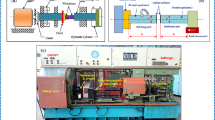Abstract
This study investigates improvement effects of fatigue strength by the postweld treatments, which are hammer peening treatment and additional welding with low-temperature transformation welding material. High cycle fatigue tests with constant and variable amplitude loadings are performed on out-of-plane gusset-welded joints of girder specimens. Test results indicate that this treatment can improve fatigue life under both the constant and variable amplitude loadings. The damage accumulations (D) of as-welded and cleaning obtained by Miner’s rule with the mean curve of constant amplitude loading are conservative (D > 1.0). However, since the beneficial effects of the compressive residual stress on fatigue life should decrease due to the relaxation of compressive residual stress, the D in specimens prepared by cleaning plus pneumatic peening, cleaning plus electric peening, and additional welding with low-temperature transformation welding material are extremely nonconservative (D ≈ 0.2–0.6). The modified Miner’s rule based on the results of fatigue test with constant maximum stress, which is the same as the maximum stress in the variable amplitude loading, is appropriate to the improved welded joints.


























Similar content being viewed by others
References
Konishi T, Takahashi K, Miki C (2000) Application of high strength steel on steel bridge and its effect on weight reduction. Proc JSCE 654:91–103
Zhang Y-H, Maddox SJ (2009) Fatigue life prediction for toe ground welded joints. Int J Fatigue 31:1124–1136
Roy S, Fisher JW, Yen BT (2003) Fatigue resistance of welded details enhanced by ultrasonic impact treatment (UIT). Int J Fatigue 25(9–11):1239–1247
Weich I (2009) Edge layer condition and fatigue strength of welds improved by mechanical post weld treatment. IIW Document XIII-2265-09
Ohta A, Watanabe O, Matsuoka K, Siga T, Nishijima S, Maeda Y, Suzuki N, Kudo T (1999) Fatigue strength improvement by using newly developed low transformation temperature welding material. Welding in the World 43(6):38–42
Machida F Improvement of fatigue strength of box weld on non-quenched steel by using low transformation temperature welding material. IIW-Doc.-XIII-1771-99
Miki C, Anami K, Higuchi Y (2002) Fatigue strength improvement by additional welding with low temperature transformation welding material. Proc JSCE 710:311–319, in Japanese
Huo L, Wang D, Zhang Y (2005) Investigation of the fatigue behaviors of the welded joints treated by TIG dressing and ultrasonic peening under variable amplitude load. Int J Fatigue 27:95–101
Barsoum Z, Gustafsson M (2009) Fatigue of high strength steel joints welded with low temperature transformation consumables. Eng Fract Anal 16(7):2186–2194
Marquis G (2010) Failure modes and fatigue strength of improved HSS weld. Eng Fract Mech 77:2051–2062
Haagensen PJ, Maddox SJ (2010) IIW recommendations on post weld fatigue life improvement of steel and aluminum structures. IIW Document XIII-2200r7-07
Tai M, Miki C (2011) Improvement effect of fatigue strength by peening treatment under variable amplitude loadings. IIW Document XIII-2378-11
Anami K, Miki C (1997) The study on size effects of fatigue strength of weld joints. J Steel Constr 4(14):9–16, in Japanese
Schajer GS (1981) Application of finite element calculations to residual stress measurements. Mater Technol 103(2):157–163
Schajer GS (1988) Measurement of non-uniform residual stresses using the hole drilling method. Part I—stress calculation procedures. Mater Technol 110(4):338–343
Schajer GS (1988) Measurement of non-uniform residual stresses using the hole drilling method. Part II—practical application of the integral method. Mater Technol 110(4):344–349
Anami K, Miki C, Yamamoto H, Higuchi Y (2001) Fatigue strength of welded joint made of high strength steel and fatigue strength improvement. Proc JSCE 675:251–260, in Japanese
Hobbacher A (2007) Recommendations for fatigue design of welded joints and components. IIW Document XIII-2151-07
Miner MA (1945) Cumulative damage in fatigue. Trans ASME J Appl Mech 67(12):A159–A164
Sonsino CM, Maddox SJ, Hobbacher A (2004) Fatigue life assessment of welded joints under variable amplitude loading—state of present knowledge and recommendations for fatigue design regulations. Proceedings of the Annual IIW-Assembly and Int. Conference
Sonsino CM (2007) Fatigue testing under variable amplitude loading. Int J Fatigue 29:1080–1089
Author information
Authors and Affiliations
Corresponding author
Additional information
Doc. IIW-2394, recommended for publication by Commission XIII “Fatigue of Welded Components and Structures”.
Rights and permissions
About this article
Cite this article
Miki, C., Tai, M. Fatigue strength improvement of out-of-plane welded joints of steel girder under variable amplitude loading. Weld World 57, 823–840 (2013). https://doi.org/10.1007/s40194-013-0076-9
Received:
Accepted:
Published:
Issue Date:
DOI: https://doi.org/10.1007/s40194-013-0076-9




